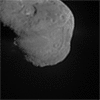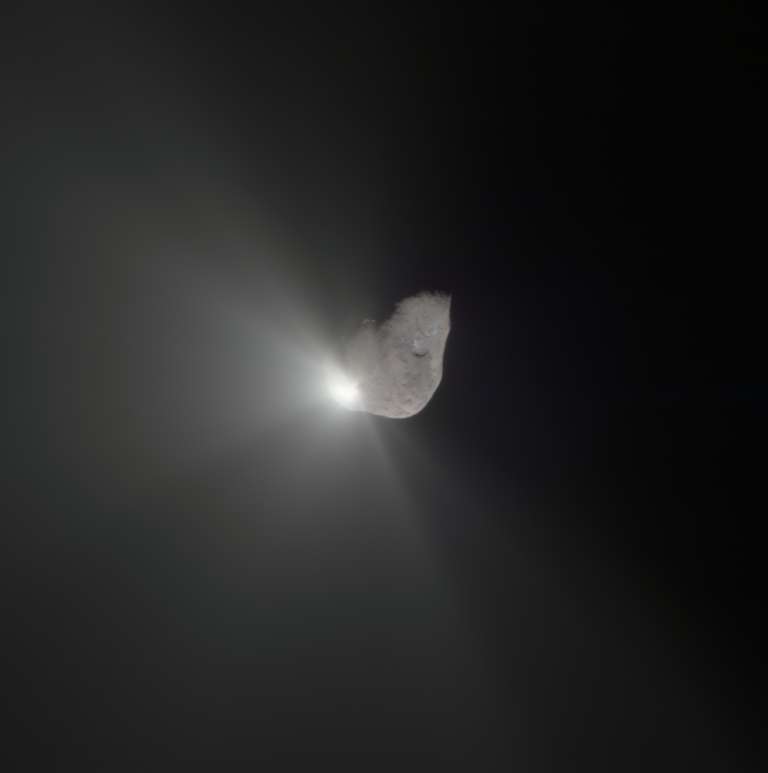Emily Lakdawalla • Jan 19, 2011
Stardust prepares for first second look at a comet: Tempel 1 on February 14
A press briefing was held at NASA Headquarters this morning to preview the planned February 14 encounter by Stardust with Tempel 1. There aren't often lots of questions from media after these "preview" briefings, but today there were zero. That's not good. It looks like it's up to us space fans to advertise the fact that we're a month away from getting the first-ever second look at a comet!
(A pedantic reader has pointed out to me that Halley was visited more than once, but that was all at the same apparition; Tempel 1 is the first that'll be seen again after it's gone through its "perihelion passage," its close approach to the sun when it bakes and vents and behaves like a comet.)
Here's the facts about this upcoming flyby. Stardust launched on February 7, 1999. The goal of the original mission was to visit comet Wild-2, which it flew past on January 2, 2004, collecting comet dust in a capsule, and gathering photos and other data on the comet nucleus.
Meanwhile, the Deep Impact mission launched on January 12, 2005 to do more than observe a comet. Deep Impact consisted of two spacecraft, the Flyby and Impactor. On July 4, 2005, the spacecraft separated, and the Impactor crashed into comet 9P/Tempel 1 as the Flyby craft watched.

Deep Impact took lots of photos and learned much about the comet (see the Planetary Society news coverage here), but there was one goal they didn't manage to reach: they had hoped to catch photos of the impact crater left behind by the crash. The size and shape of the crater would have told us a lot about the interior structure of the comet. But the crater site was obscured by the unexpectedly large amount of light-scattering dust that was tossed into space after the crash.
Not seeing the crater wasn't just a disappointment to the science team; it was a disappointment also to the 1,800 people who'd guessed how big the crater would turn out to be in the Planetary Society's Great Comet Crater Contest. In the end, the science team was only able to estimate the final crater as being somewhere between 100 and 250 meters in diameter. (For comparison, the comet is about 7600 by 4900 meters in diameter.) Deep Impact left Tempel 1, never to return again, though it did successfully accomplish an extended mission including a flyby last November of comet 103P/Hartley 2.
Back on the Stardust mission, the sample capsule was successfully returned to Earth on January 19, 2006. Since then, as Joe Veverka summarized in this morning's briefing, the Stardust samples have been analyzed in laboratories around the world, and they continue to provide information about the formation of comets and the whole solar system. (Members of the public continue to search for interstellar dust grains in the Stardust@home citizen science project.) Veverka said Stardust "was a great success and left a perfectly good spacecraft still out in space. In 2006 it was decided to reuse the spacecraft and send it on to another comet, Tempel 1. It will be the first time we'll be able to see changes after a comet has passed through one perihelion." And, of course, "We would like to complete the Deep Impact experiment and see how big the impact crater is. "Plans for the Stardust Tempel 1 encounter

One very important thing to keep in mind is that Stardust was designed, built, and launched six years before Deep Impact. While six years is not that long in human terms, Stardust's computers, science instruments, and data recorders are all significantly less capable than Deep Impact's were. The Navigational Camera has a 1024-by-1024 pixel detector, but suffered since before the Wild 2 encounter from two problems: a fuzzing of images due to some contamination within the system, and a stuck filter wheel, preventing color imaging. They were able to deal with the contamination before the Wild 2 flyby by heating the system. Fortunately, the filter wheel got stuck in the broadband ("clear") filter position, which means the camera is still useable for optical navigation.
The flyby will take place at 04:37 UTC on February 15 (21:37 PST February 14) at a distance of 200 kilometers and a relative speed of 10 kilometers per second. For comparison, the Wild 2 flyby happened at a distance of 236 kilometers and a relative speed of 6 kilometers per second.

Stardust will line up for the encounter with a final trajectory correction maneuver 48 hours before the flyby, after which the last optical navigation photos will be taken. Back on Earth, the team will use those photos to build the final encounter sequence, uploading it to the spacecraft 24 hours before. Stardust is now nearly on the opposite side of the Sun from Earth, more than two astronomical units away, so the round-trip light time is nearly 40 minutes, making realtime commanding impossible.
So, beginning 24 hours before the encounter, the spacecraft will be operating autonomously. Two hours before the flyby, it'll turn to shield orientation, with its dust shields facing toward the comet, protecting the rest of the craft from comet particles. (Its instruments poke out from behind the shields; the camera has a clever periscope with steerable aluminum mirror in order to keep the optics and electronics safely behind the shields.) One hour before the flyby, the spacecraft will switch from pre-programmed to autonomous navigation, where it will use its camera images iteratively to set the aimpoint for subsequent images. A total of 72 images are planned, with the very best having a resolution of, at best, 12 meters per pixel.


The spacecraft will turn to begin returning data to Earth one hour after the flyby; it'll take 12 hours to get the entire encounter's data to the ground. But the first images should be available to the team by midnight California time. The press release states that images are expected to be available to the public a mere hour and a half later, at about 09:30 UTC (01:30 PST) on February 15. It won't be easy
Every member of the team on this morning's press panel expressed both confidence and excitement about the upcoming encounter. But there are a few significant challenges facing the mission. Among them, as project manager Tim Larson explained, is the fact that Stardust appears to have just barely enough fuel remaining to perform this flyby. Stardust has no reaction wheels, so not only does it need fuel to target the 200-kilometer flyby distance, it also needs fuel to control its orientation in space. That matters for imaging and for communications with Earth. Larson said, "We are confident that we will have enough fuel to finish the mission, though after the mission there won't be much left that the spacecraft can do." Which is really a pretty extreme statement from a project manager; clearly the fuel budget is very, very tight.
Another challenge is that the comet hasn't yet shown up in their optical navigation images. It is being observed from Earth, so we do know that it's right about where it is supposed to be; in fact, as co-investigator Steve Chesley said today, a worldwide effort involving dozens of telescopes over ten years has led to Tempel 1 being "the best-observed comet in the catalogue." But in order to fine-tune the trajectory the spacecraft has to be able to see the comet, and the longer it takes to see the comet, the more fuel it may require to fine-tune the trajectory. Current models of the brightness of the comet -- and of the performance of that foggy imaging system -- suggest that it should, hopefully, show up in the optical navigation images toward the end of this month. Sooner would sure be better!
Finally, the comet is being a little coy in another way. The flyby will happen so fast that Stardust (like Deep Impact before it) will only see one half of the comet's nucleus; it'll be night on the other side, and there won't be any significant amount of rotation during the highest-resolution imaging. So if they want to see the Deep Impact crater, they have to make sure that the right spot on the comet will be (a) in sunlight and (b) on the side of the comet that faces Stardust. We haven't been there for five years, so in order to know where the crater is, we have to have very precise knowledge of the comet's rotation rate. But comets aren't like planets. They have jets and things that make their rotation rate and even their orbital position change with time.
So part of the reason that astronomers have been working so hard to observe Tempel 1 is to make sure they know where the right side of the comet is so that Stardust can fly by at the right time to have the Deep Impact crater in sunlight facing the spacecraft. Astronomers figure out the rotation rate of a body by watching its light curve -- how its brightness varies with time. An elongated body will appear brighter in the sky when we are seeing its wide side, and less bright when we're looking at one of its ends, when it presents a smaller reflecting area to us.
Tempel 1 turns out to have a strongly double-bumped light curve. To make a long story short, the double bump in the light curve means we'll either see the crater or we won't; astronomers have either correctly figured out which direction is facing Stardust right now, or they are off by 180 degrees and we will have exactly the opposite view to what we want. (In that map of Tempel 1 above, shift the yellow area 180 degrees; it won't overlap the red bull's eye marking the crater at all.) In either case, the mission scientists will get a chance to re-image areas of the comet that were seen by Deep Impact and thus accomplish the primary goal of this flyby, which is to revisit a comet after one perihelion passage to see what has changed since the comet last approached the Sun. But if they're off by 180 degrees, we won't get a chance to see that stupid crater that eluded us the first time. Chesley expressed "confidence" in their choice though. Cross your fingers that he's right!



 Explore Worlds
Explore Worlds Find Life
Find Life Defend Earth
Defend Earth


